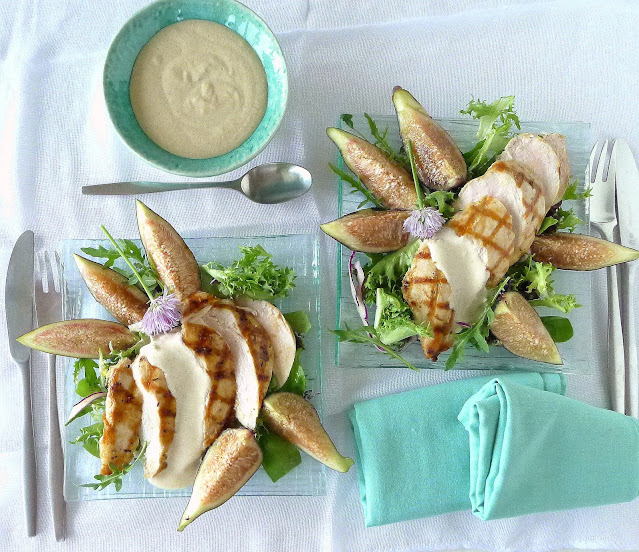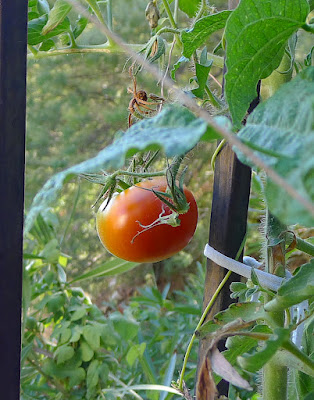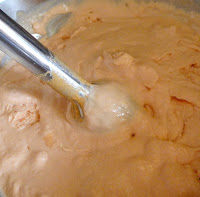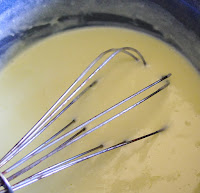 |
| Dead-ripe figs are squishy but extraordinarily sweet. |
Fruits have their seasons. Oranges in the winter; strawberries in spring; peaches, melons and grapes that ripen in full summer, and, looking ahead, pomegranates, persimmons and pears for fall. But the fruit that spans all seasons is the fig.
The breva, an early fig, arrives in late spring. By late summer, the main crop of figs ripens, giving us fruit of incredible sweetness. Ripe figs are soft-skinned, very perishable. Unless, of course, they are carefully dried and stored for enjoying into fall and winter. Dried figs are like an entirely different fruit.
I was given an enormous basket of dead-ripe summer figs. Some we ate fresh and in salads, with or without peeling. The rest, I washed, dried, removed stems, discarding any that were totally mushy, and packed in freezer bags. I will use the frozen figs for making ice cream (actually, frozen yogurt), a dessert that needs no added sugar.
I make some version of this frozen dessert year-round, changing the fruit with the seasons. With some fruits, I need to add edulcorante, artificial sweetener (I use liquid stevia). But figs are so sweet, no additional sweetener is needed.
I use non-fat yogurt and queso batido, a beaten cottage cheese or non-fat sour cream, plus a small quantity of mascarpone to add a little richness. (If non-fat is not your thing, use real cream instead of the yogurt.) Use an ice cream freezer if you have one. Otherwise, freeze the fig cream until partially frozen. Whip it again with blender or processor and return to the freezer.
Once frozen, the ice cream needs to be softened before it's ready to serve. I like to freeze the cream in small cups, so I can take out only as many as are needed, rather than thaw the whole bowl.
Makes 8 (½ -cup) servings.
1 ½ - 2 cups chopped fresh figs
Lemon juice
1 ½ cups plain non-fat yogurt
1 ½ cups plain non-fat queso batido
½ cup mascarpone or full-fat Greek yogurt
Vanilla extract or grated ginger
Place figs in large blender or food processor with lemon juice, yogurt, queso batido, mascarpone and vanilla or ginger. Blend until very smooth. Pour into a metal container and freeze. When the mixture is the consistency of soft-freeze, remove and beat it again until smooth.
Divide the ice cream between 8 small cups. Place them on a tray and return to the freezer.
Allow the ice cream to soften 15 to 20 minutes before serving.
More recipes with fresh figs:
Fig Salsa Salsa Picante de Higos
Substitute fresh figs for tomatillos or tomatoes in your favorite salsa recipe. Add chile to taste. I've used chopped mint instead of cilantro for a fresh taste and plenty of lemon juice. The salsa is terrific with lamb chops on the grill. Recipe is here.
Fig and Goat Cheese Flatbread
Coca con Higos y Queso de Cabra
Figgy Fritters Buñuelos de Higos Frescos
Firm, ripe figs are dipped in a fritter batter and fried in olive oil. Here they are served with ice cream. See the recipe for Figgy Fritters.
Grilled Figs and Bacon
Higos con Bacón a la Parilla
These are unbelievably delicious, perfect for a late summer grill meal. They are a version of "devils on horseback," made with fresh figs instead of dates. Stuff them with fresh goat cheese, wrap them in bacon and grill. Directions are here.
Figs with Serrano Ham
Higos con Jamón Serrano
The easiest dish of all, sweet figs paired with salty serrano (or ibérico) ham. The figs pictured are brevas, the early figs (May-June) that aren't as ruby-red as the late summer ones. (Brevas are pictured below.)
Grilled Chicken and Fig Salad
Ensalada de Pollo con Higos
This main course salad can be made with any fresh figs, early brevas or late summer ones. The dressing is Ajoblanco Sauce, a thick version of white gazpacho, with ground almonds and garlic. The recipes are here.
 |
| Salad of grilled chicken with quartered figs and ajoblanco sauce. |
Hot Gazpacho with Figs
Gazpacho Caliente con Higos







































